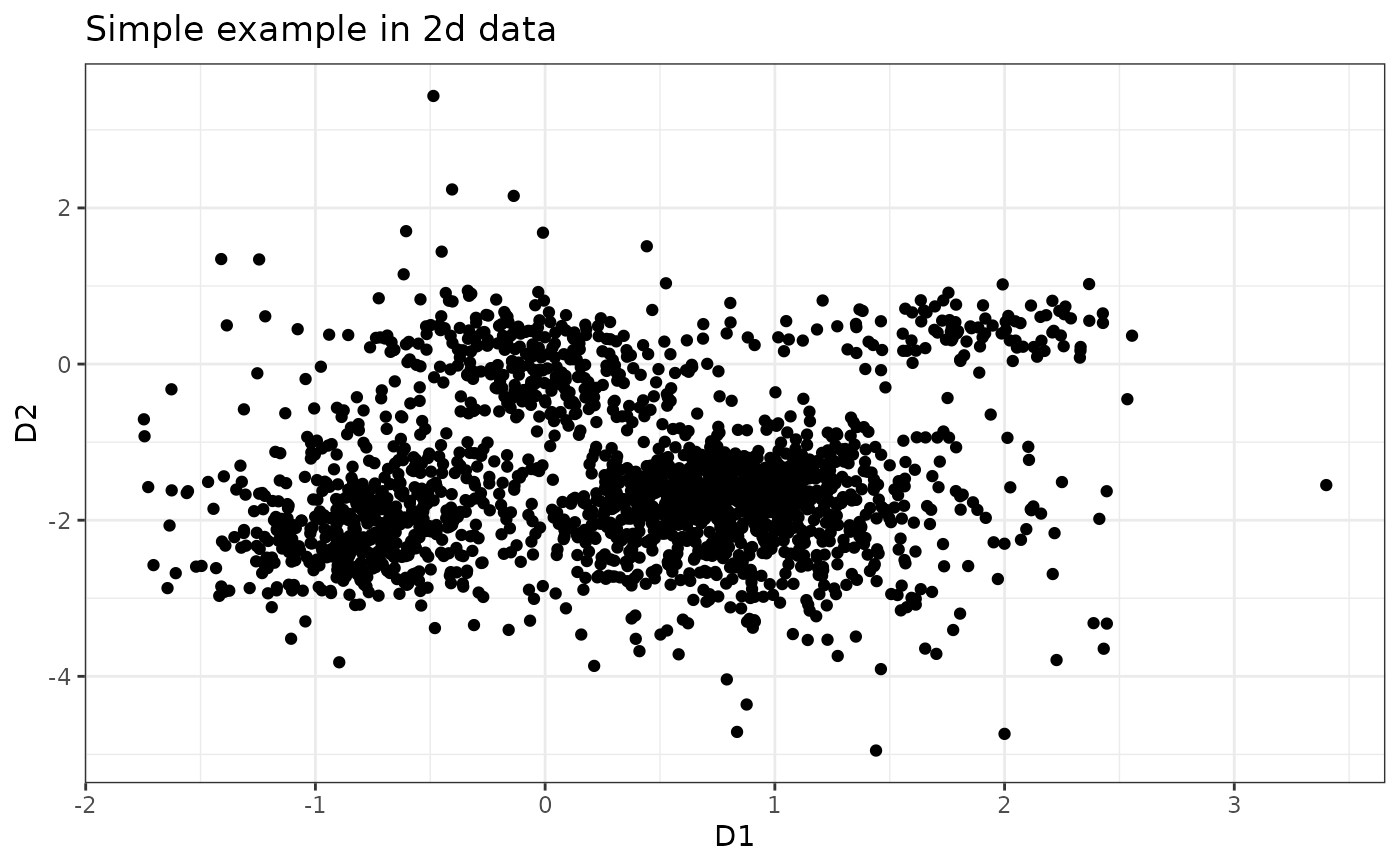Slice Sampling of Dirichlet Process Mixture of skew Student's t-distributions
Source:R/DPMGibbsSkewT_SeqPrior_parallel.R
DPMGibbsSkewT_SeqPrior_parallel.RdSlice Sampling of Dirichlet Process Mixture of skew Student's t-distributions
Usage
DPMGibbsSkewT_SeqPrior_parallel(
Ncpus,
type_connec,
z,
prior_inform,
hyperG0,
N,
nbclust_init,
add.vagueprior = TRUE,
weightnoninfo = NULL,
doPlot = FALSE,
plotevery = N/10,
diagVar = TRUE,
verbose = TRUE,
monitorfile = "",
...
)Arguments
- Ncpus
the number of processors available
- type_connec
The type of connection between the processors. Supported cluster types are
"SOCK","FORK","MPI", and"NWS". See alsomakeCluster.- z
data matrix
d x nwithddimensions in rows andnobservations in columns.- prior_inform
an informative prior such as the approximation computed by
summary.DPMMclust.- hyperG0
prior mixing distribution.
- N
number of MCMC iterations.
- nbclust_init
number of clusters at initialization. Default to 30 (or less if there are less than 30 observations).
- add.vagueprior
logical flag indicating whether a non informative component should be added to the informative prior. Default is
TRUE.- weightnoninfo
a real between 0 and 1 giving the weights of the non informative component in the prior.
- doPlot
logical flag indicating whether to plot MCMC iteration or not. Default to
TRUE.- plotevery
an integer indicating the interval between plotted iterations when
doPlotisTRUE.- diagVar
logical flag indicating whether the variance of each cluster is estimated as a diagonal matrix, or as a full matrix. Default is
TRUE(diagonal variance).- verbose
logical flag indicating whether partition info is written in the console at each MCMC iteration.
- monitorfile
a writable connections or a character string naming a file to write into, to monitor the progress of the analysis. Default is
""which is no monitoring. See Details.- ...
additional arguments to be passed to
plot_DPM. Only used ifdoPlotisTRUE.
Value
a object of class DPMclust with the following attributes:
mcmc_partitions:a list of length
N. Each elementmcmc_partitions[n]is a vector of lengthngiving the partition of thenobservations.alpha:a vector of length
N.cost[j]is the cost associated to partitionc[[j]]U_SS_list:a list of length
Ncontaining the lists of sufficient statistics for all the mixture components at each MCMC iterationweights_list:a list of length
Ncontaining the logposterior values at each MCMC iterationslogposterior_list:a list of length
Ncontaining the logposterior values at each MCMC iterationsdata:the data matrix
d x nwithddimensions in rows andnobservations in columnsnb_mcmcit:the number of MCMC iterations
clust_distrib:the parametric distribution of the mixture component -
"skewt"hyperG0:the prior on the cluster location
References
Hejblum BP, Alkhassim C, Gottardo R, Caron F and Thiebaut R (2019) Sequential Dirichlet Process Mixtures of Multivariate Skew t-distributions for Model-based Clustering of Flow Cytometry Data. The Annals of Applied Statistics, 13(1): 638-660. <doi: 10.1214/18-AOAS1209> <arXiv: 1702.04407> https://arxiv.org/abs/1702.04407 doi:10.1214/18-AOAS1209
Examples
rm(list=ls())
#Number of data
n <- 2000
set.seed(123)
d <- 2
ncl <- 4
# Sample data
sdev <- array(dim=c(d,d,ncl))
#xi <- matrix(nrow=d, ncol=ncl, c(-1.5, 1.5, 1.5, 1.5, 2, -2.5, -2.5, -3))
#psi <- matrix(nrow=d, ncol=4, c(0.4, -0.6, 0.8, 0, 0.3, -0.7, -0.3, -0.8))
xi <- matrix(nrow=d, ncol=ncl, c(-0.2, 0.5, 2.4, 0.4, 0.6, -1.3, -0.9, -2.7))
psi <- matrix(nrow=d, ncol=4, c(0.3, -0.7, -0.8, 0, 0.3, -0.7, 0.2, 0.9))
nu <- c(100,15,8,5)
p <- c(0.15, 0.05, 0.5, 0.3) # frequence des clusters
sdev[, ,1] <- matrix(nrow=d, ncol=d, c(0.3, 0, 0, 0.3))
sdev[, ,2] <- matrix(nrow=d, ncol=d, c(0.1, 0, 0, 0.3))
sdev[, ,3] <- matrix(nrow=d, ncol=d, c(0.3, 0.15, 0.15, 0.3))
sdev[, ,4] <- .3*diag(2)
c <- rep(0,n)
w <- rep(1,n)
z <- matrix(0, nrow=d, ncol=n)
for(k in 1:n){
c[k] = which(rmultinom(n=1, size=1, prob=p)!=0)
w[k] <- rgamma(1, shape=nu[c[k]]/2, rate=nu[c[k]]/2)
z[,k] <- xi[, c[k]] + psi[, c[k]]*rtruncnorm(n=1, a=0, b=Inf, mean=0, sd=1/sqrt(w[k])) +
(sdev[, , c[k]]/sqrt(w[k]))%*%matrix(rnorm(d, mean = 0, sd = 1), nrow=d, ncol=1)
#cat(k, "/", n, " observations simulated\n", sep="")
}
# Set parameters of G0
hyperG0 <- list()
hyperG0[["b_xi"]] <- rowMeans(z)
hyperG0[["b_psi"]] <- rep(0,d)
hyperG0[["kappa"]] <- 0.001
hyperG0[["D_xi"]] <- 100
hyperG0[["D_psi"]] <- 100
hyperG0[["nu"]] <- d+1
hyperG0[["lambda"]] <- diag(apply(z,MARGIN=1, FUN=var))/3
# hyperprior on the Scale parameter of DPM
a <- 0.0001
b <- 0.0001
# do some plots
nbclust_init <- 30
## Plot Data
library(ggplot2)
q <- (ggplot(data.frame("X"=z[1,], "Y"=z[2,]), aes(x=X, y=Y))
+ geom_point()
+ ggtitle("Simple example in 2d data")
+xlab("D1")
+ylab("D2")
+theme_bw())
q
 if(interactive()){
MCMCsample_st <- DPMGibbsSkewT(z, hyperG0, a, b, N=2000,
doPlot=TRUE, plotevery=250,
nbclust_init,
gg.add=list(theme_bw(),
guides(shape=guide_legend(override.aes = list(fill="grey45")))),
diagVar=FALSE)
s <- summary(MCMCsample_st, burnin = 1500, thin=5, posterior_approx=TRUE)
F <- FmeasureC(pred=s$point_estim$c_est, ref=c)
for(k in 1:n){
c[k] = which(rmultinom(n=1, size=1, prob=p)!=0)
w[k] <- rgamma(1, shape=nu[c[k]]/2, rate=nu[c[k]]/2)
z[,k] <- xi[, c[k]] + psi[, c[k]]*rtruncnorm(n=1, a=0, b=Inf, mean=0, sd=1/sqrt(w[k])) +
(sdev[, , c[k]]/sqrt(w[k]))%*%matrix(rnorm(d, mean = 0, sd = 1), nrow=d, ncol=1)
#cat(k, "/", n, " observations simulated\n", sep="")
}
MCMCsample_st2 <- DPMGibbsSkewT_SeqPrior_parallel(Ncpus=2, type_connec="SOCK",
z, prior_inform=s$param_posterior,
hyperG0, N=3000,
doPlot=TRUE, plotevery=100,
nbclust_init, diagVar=FALSE, verbose=FALSE,
gg.add=list(theme_bw(),
guides(shape=guide_legend(override.aes = list(fill="grey45")))))
s2 <- summary(MCMCsample_st2, burnin = 2000, thin=5)
F2 <- FmeasureC(pred=s2$point_estim$c_est, ref=c)
}
if(interactive()){
MCMCsample_st <- DPMGibbsSkewT(z, hyperG0, a, b, N=2000,
doPlot=TRUE, plotevery=250,
nbclust_init,
gg.add=list(theme_bw(),
guides(shape=guide_legend(override.aes = list(fill="grey45")))),
diagVar=FALSE)
s <- summary(MCMCsample_st, burnin = 1500, thin=5, posterior_approx=TRUE)
F <- FmeasureC(pred=s$point_estim$c_est, ref=c)
for(k in 1:n){
c[k] = which(rmultinom(n=1, size=1, prob=p)!=0)
w[k] <- rgamma(1, shape=nu[c[k]]/2, rate=nu[c[k]]/2)
z[,k] <- xi[, c[k]] + psi[, c[k]]*rtruncnorm(n=1, a=0, b=Inf, mean=0, sd=1/sqrt(w[k])) +
(sdev[, , c[k]]/sqrt(w[k]))%*%matrix(rnorm(d, mean = 0, sd = 1), nrow=d, ncol=1)
#cat(k, "/", n, " observations simulated\n", sep="")
}
MCMCsample_st2 <- DPMGibbsSkewT_SeqPrior_parallel(Ncpus=2, type_connec="SOCK",
z, prior_inform=s$param_posterior,
hyperG0, N=3000,
doPlot=TRUE, plotevery=100,
nbclust_init, diagVar=FALSE, verbose=FALSE,
gg.add=list(theme_bw(),
guides(shape=guide_legend(override.aes = list(fill="grey45")))))
s2 <- summary(MCMCsample_st2, burnin = 2000, thin=5)
F2 <- FmeasureC(pred=s2$point_estim$c_est, ref=c)
}